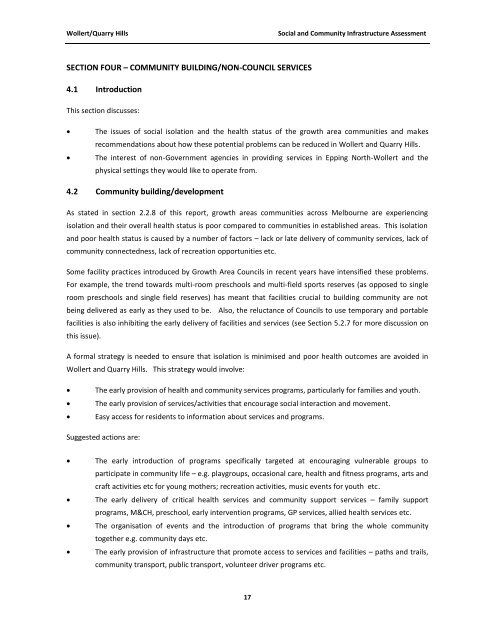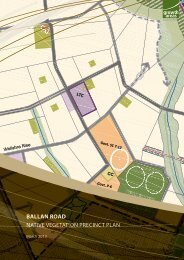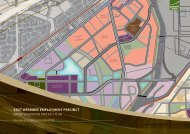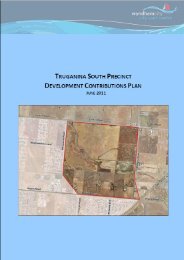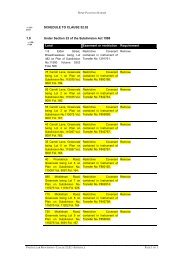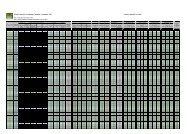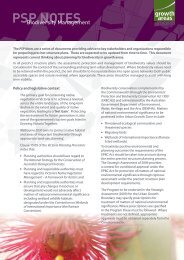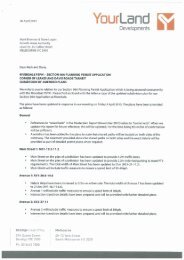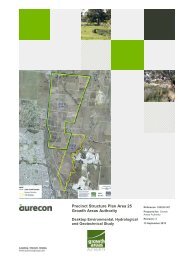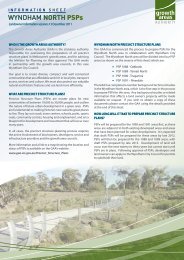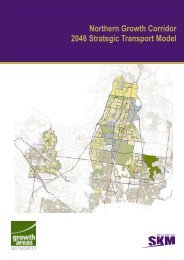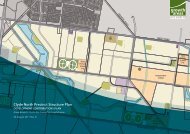Social and Community Infrastructure Assessment - Growth Areas ...
Social and Community Infrastructure Assessment - Growth Areas ...
Social and Community Infrastructure Assessment - Growth Areas ...
You also want an ePaper? Increase the reach of your titles
YUMPU automatically turns print PDFs into web optimized ePapers that Google loves.
Wollert/Quarry Hills <strong>Social</strong> <strong>and</strong> <strong>Community</strong> <strong>Infrastructure</strong> <strong>Assessment</strong><br />
SECTION FOUR – COMMUNITY BUILDING/NON-COUNCIL SERVICES<br />
4.1 Introduction<br />
This section discusses:<br />
The issues of social isolation <strong>and</strong> the health status of the growth area communities <strong>and</strong> makes<br />
recommendations about how these potential problems can be reduced in Wollert <strong>and</strong> Quarry Hills.<br />
The interest of non-Government agencies in providing services in Epping North-Wollert <strong>and</strong> the<br />
physical settings they would like to operate from.<br />
4.2 <strong>Community</strong> building/development<br />
As stated in section 2.2.8 of this report, growth areas communities across Melbourne are experiencing<br />
isolation <strong>and</strong> their overall health status is poor compared to communities in established areas. This isolation<br />
<strong>and</strong> poor health status is caused by a number of factors – lack or late delivery of community services, lack of<br />
community connectedness, lack of recreation opportunities etc.<br />
Some facility practices introduced by <strong>Growth</strong> Area Councils in recent years have intensified these problems.<br />
For example, the trend towards multi-room preschools <strong>and</strong> multi-field sports reserves (as opposed to single<br />
room preschools <strong>and</strong> single field reserves) has meant that facilities crucial to building community are not<br />
being delivered as early as they used to be. Also, the reluctance of Councils to use temporary <strong>and</strong> portable<br />
facilities is also inhibiting the early delivery of facilities <strong>and</strong> services (see Section 5.2.7 for more discussion on<br />
this issue).<br />
A formal strategy is needed to ensure that isolation is minimised <strong>and</strong> poor health outcomes are avoided in<br />
Wollert <strong>and</strong> Quarry Hills. This strategy would involve:<br />
The early provision of health <strong>and</strong> community services programs, particularly for families <strong>and</strong> youth.<br />
The early provision of services/activities that encourage social interaction <strong>and</strong> movement.<br />
Easy access for residents to information about services <strong>and</strong> programs.<br />
Suggested actions are:<br />
The early introduction of programs specifically targeted at encouraging vulnerable groups to<br />
participate in community life – e.g. playgroups, occasional care, health <strong>and</strong> fitness programs, arts <strong>and</strong><br />
craft activities etc for young mothers; recreation activities, music events for youth etc.<br />
The early delivery of critical health services <strong>and</strong> community support services – family support<br />
programs, M&CH, preschool, early intervention programs, GP services, allied health services etc.<br />
The organisation of events <strong>and</strong> the introduction of programs that bring the whole community<br />
together e.g. community days etc.<br />
The early provision of infrastructure that promote access to services <strong>and</strong> facilities – paths <strong>and</strong> trails,<br />
community transport, public transport, volunteer driver programs etc.<br />
17


